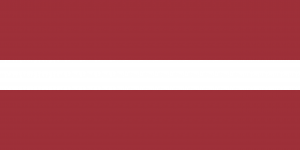Language/Standard-latvian/Culture/Major-historical-events-and-figures
| ◀️ Jobs and professions — Previous Lesson | Next Lesson — Modern politics and society ▶️ |
Introduction: Welcome to the lesson on major historical events and figures in Latvian history. In this lesson, we will explore key moments and personalities that have shaped the rich history of Latvia. Understanding the historical context of a language is essential for a complete understanding of its culture and people. By delving into Latvia's past, we can gain a deeper appreciation for the Latvian language and its significance to the country's identity. Throughout this lesson, we will explore various historical periods, from prehistory to the medieval era, and finally, the 20th century. So let's dive in and discover the fascinating history of Latvia!
Prehistory[edit | edit source]
Latvia's history dates back thousands of years, and understanding its prehistoric period is crucial to comprehend the country's early development. Archaeological evidence suggests that the territory of present-day Latvia was inhabited as early as the Paleolithic era, around 10,000 BCE. Throughout the Neolithic and Bronze ages, various tribes settled in the region and developed agricultural practices.
One of the most significant archaeological sites in Latvia is the Kūldiga Mound, which dates back to the Iron Age. This ancient hillfort provides insights into the social structure and defensive methods used by the early inhabitants of Latvia.
The Latvian language itself has roots in the Indo-European language family and is closely related to Lithuanian. As we explore Latvia's history, we will also examine how the language has evolved over time.
Medieval Period[edit | edit source]
The medieval period played a crucial role in shaping Latvia's cultural and political landscape. During this time, the region was under the rule of various powers, including the Livonian Order, the Teutonic Knights, and the Polish-Lithuanian Commonwealth.
One of the most notable figures from this era is Bishop Albert of Riga, who founded the city of Riga in 1201 and played a significant role in the Christianization of the region. Riga quickly became a major center of trade and culture in the Baltic region.
The Hanseatic League, a powerful trading alliance of Northern European cities, had a significant influence on medieval Latvia. Riga, along with other cities such as Tallinn and Gdansk, was a member of the league and benefited greatly from the trade routes and cultural exchange it facilitated.
The 20th Century[edit | edit source]
The 20th century was a tumultuous period in Latvian history, marked by both progress and tragedy. Latvia first declared independence from the Russian Empire in 1918, establishing the Republic of Latvia. This period of independence was characterized by rapid economic development and cultural flourishing.
One of the most significant events in Latvia's modern history is the signing of the Latvian-Soviet Peace Treaty in 1920, which recognized Latvia's independence. This treaty marked the beginning of diplomatic relations between Latvia and the Soviet Union.
However, Latvia's independence was short-lived, as the country was occupied by the Soviet Union in 1940, and later by Nazi Germany during World War II. This period of occupation brought immense suffering to the Latvian people, with many being deported or killed.
After the end of World War II, Latvia was once again incorporated into the Soviet Union, and the country experienced a period of Sovietization. However, the desire for independence never waned among the Latvian people, and in 1991, Latvia finally regained its independence following the collapse of the Soviet Union.
Throughout this turbulent century, many Latvians played significant roles in shaping the country's history. Notable figures include Kārlis Ulmanis, a prominent political leader who served as the Prime Minister and President of Latvia, and Vaira Vīķe-Freiberga, the first female President of Latvia.
Exercises[edit | edit source]
1. Match the following historical events with their corresponding descriptions:
a. The signing of the Latvian-Soviet Peace Treaty b. The founding of Riga by Bishop Albert c. Latvia's declaration of independence in 1918
i. A significant milestone in Latvia's modern history that led to diplomatic recognition ii. The establishment of a major Baltic trading center iii. A period of rapid economic development and cultural flourishing
Solution: a - i b - ii c - iii
2. Fill in the blanks with the appropriate historical figure:
a. _______ was a prominent political leader who served as the Prime Minister and President of Latvia. b. _______ was the first female President of Latvia.
Solution: a - Kārlis Ulmanis b - Vaira Vīķe-Freiberga
3. Discuss with a partner: How do you think Latvia's historical events have influenced its language and culture?
Solution: Answers may vary. Students should discuss the impact of historical events on language, culture, and national identity.
Conclusion[edit | edit source]
In this lesson, we have explored major historical events and figures that have shaped Latvia's past. From the prehistoric period to the medieval era and the 20th century, each time period has left its mark on Latvian language, culture, and identity. By understanding Latvia's history, we can gain a deeper appreciation for the Standard Latvian language and its significance to the country's people. In the next lesson, we will delve into modern politics and society in Latvia, further expanding our knowledge of this beautiful Baltic nation.
Other Lessons[edit | edit source]
- Nature and outdoor recreation
- Latvian holidays and celebrations
- Latvian nature and national parks
- Latvian museums and exhibitions
- Latvian folklore and crafts
- Modern politics and society
- Latvia Timeline
- Popular sports and events
- Latvian cities and regions
| ◀️ Jobs and professions — Previous Lesson | Next Lesson — Modern politics and society ▶️ |

